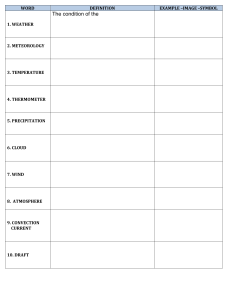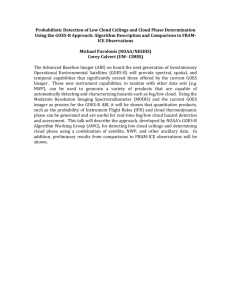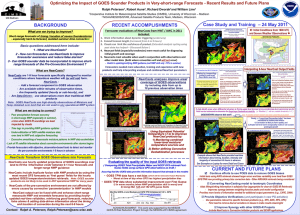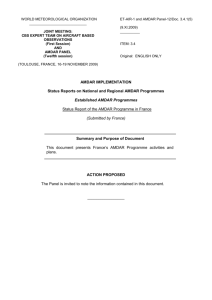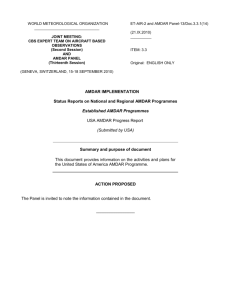SoG for Aeronautical Meteorology
advertisement
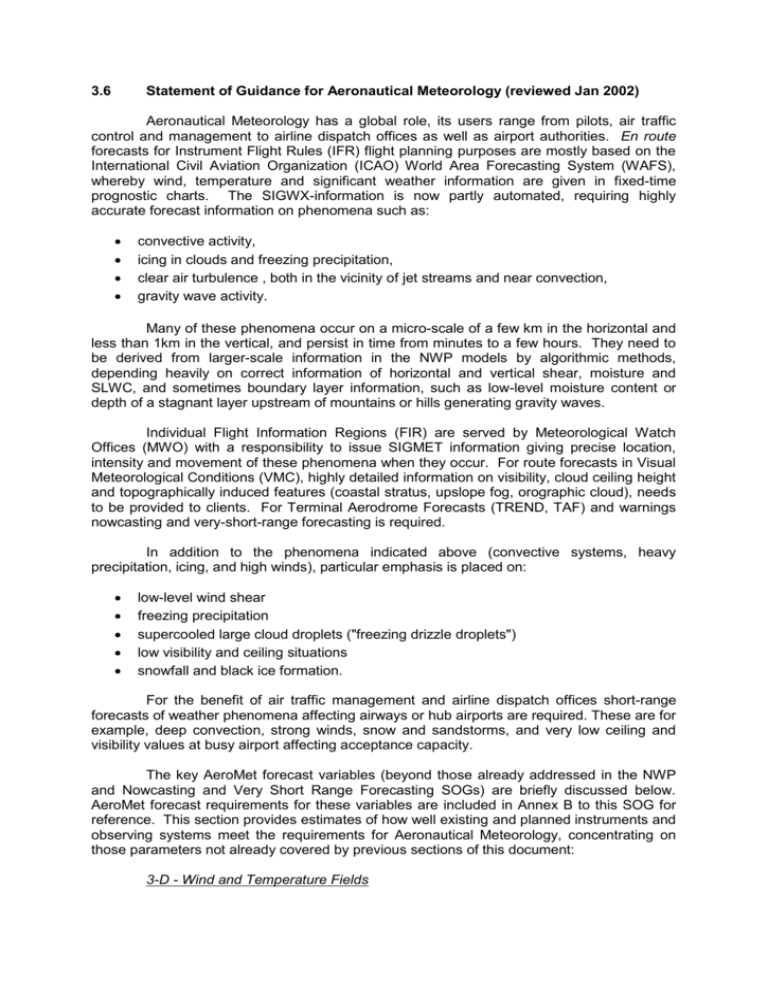
3.6 Statement of Guidance for Aeronautical Meteorology (reviewed Jan 2002) Aeronautical Meteorology has a global role, its users range from pilots, air traffic control and management to airline dispatch offices as well as airport authorities. En route forecasts for Instrument Flight Rules (IFR) flight planning purposes are mostly based on the International Civil Aviation Organization (ICAO) World Area Forecasting System (WAFS), whereby wind, temperature and significant weather information are given in fixed-time prognostic charts. The SIGWX-information is now partly automated, requiring highly accurate forecast information on phenomena such as: convective activity, icing in clouds and freezing precipitation, clear air turbulence , both in the vicinity of jet streams and near convection, gravity wave activity. Many of these phenomena occur on a micro-scale of a few km in the horizontal and less than 1km in the vertical, and persist in time from minutes to a few hours. They need to be derived from larger-scale information in the NWP models by algorithmic methods, depending heavily on correct information of horizontal and vertical shear, moisture and SLWC, and sometimes boundary layer information, such as low-level moisture content or depth of a stagnant layer upstream of mountains or hills generating gravity waves. Individual Flight Information Regions (FIR) are served by Meteorological Watch Offices (MWO) with a responsibility to issue SIGMET information giving precise location, intensity and movement of these phenomena when they occur. For route forecasts in Visual Meteorological Conditions (VMC), highly detailed information on visibility, cloud ceiling height and topographically induced features (coastal stratus, upslope fog, orographic cloud), needs to be provided to clients. For Terminal Aerodrome Forecasts (TREND, TAF) and warnings nowcasting and very-short-range forecasting is required. In addition to the phenomena indicated above (convective systems, heavy precipitation, icing, and high winds), particular emphasis is placed on: low-level wind shear freezing precipitation supercooled large cloud droplets ("freezing drizzle droplets") low visibility and ceiling situations snowfall and black ice formation. For the benefit of air traffic management and airline dispatch offices short-range forecasts of weather phenomena affecting airways or hub airports are required. These are for example, deep convection, strong winds, snow and sandstorms, and very low ceiling and visibility values at busy airport affecting acceptance capacity. The key AeroMet forecast variables (beyond those already addressed in the NWP and Nowcasting and Very Short Range Forecasting SOGs) are briefly discussed below. AeroMet forecast requirements for these variables are included in Annex B to this SOG for reference. This section provides estimates of how well existing and planned instruments and observing systems meet the requirements for Aeronautical Meteorology, concentrating on those parameters not already covered by previous sections of this document: 3-D - Wind and Temperature Fields For upper level wind forecasts, the requirements stated in the NWP section apply. For SIGWX information on turbulence, that is based on algorithmic methods, very high spatial resolution in temperature, moisture, and wind fields are required for l calculation of non-dimensional parameters such as Richardson number, Froude number, etc .Along busy air routes the required vertical resolution is increasingly available both from ACARS / AMDAR data .The degrading radiosonde network would still be able to provide significant input to turbulence forecasting if the full vertical resolution of the sounding (about 50 m in the vertical) is transmitted instead of significant and standard levels only. Surface and near-surface wind In the vicinity of airports, horizontal and vertical wind shear and sudden changes in wind speed or direction are very important for landing aircraft and air traffic management (such as change of runways). Local observing mesonets, boundary layer wind profilers and lidars as well as terminal Doppler weather radars are providing good wind information at selected locations in the developed world. Scatterometer data from satellites are beginning to provide highly valuable data in oceanic and coastal areas. Cloud-motion winds are rarely capable of providing data continuously in the planetary boundary layer over land. Humidity fields Humidity fields play a critical role in forecasting icing and convection and, as in NWP, they are currently under-sampled by existing in situ-systems except in densely populated areas. Satellite sounding systems (microwave sounders) are beginning to show positive impact over oceanic areas, but vertical resolution and availability is rather poor. Currently, the number of moisture sensors on AMDAR aircraft is far too small to have a global impact, but these observations show considerable potential for the future. Moisture information at higher flight levels may become very important if current research pointing to a significant impact of aviation generated cirrus cloud on radiative forcing is confirmed. For that reason, moisture sensors on AMDAR / ACARS aircraft could become very important and would necessitate better calibration of radiosonde moisture sensors in higher levels in the atmosphere. IAMSU data and multi-spectral sensors on research satellites and next generation geostationary satellites ,including more spectral bands in the water vapour band, are expected to have a clear positive impact. Cloud and liquid / ice water content Detection of large convective systems from cloud top height information is accomplished from multi-spectral infrared satellite sounding systems with acceptable horizontal and vertical resolution, and reduced cycle times in the order of 10 to 15 min for newer geostationary satellites will also increasingly satisfy the requirements for higher temporal resolution. Ground-based scanning Doppler radar, and lightning detection networks provide acceptable detection and have good temporal and spatial resolution and accuracy. Data exchange across national boundaries is beginning to provide information for larger areas, but are far from covering entire continents, particularly in the developing world. Cloud drop size information for icing forecasts is currently not directly observed; satellite remote sensing methods are under development and should be closely followed. Indirect methods for deriving this information are based on moisture supply, temperature inversions, and wind shear near cloud tops. Only rawinsonde and AMDAR data could provide acceptable vertical resolution of these parameters, but cycle times and horizontal resolution are marginal to poor. Polarimetric radar again holds promise for acceptable accuracy in determining the amount and distribution of SLW droplets. Visibility and cloud ceiling height These parameters are well observed at most manned aerodromes both by human observers and automated systems. For route forecasts of VFR flights, both the horizontal resolution and cycle time of existing observing stations reporting aeronautical weather information in METAR code are acceptable only in densely populated areas, and poor over most of the globe. Gravity waves Gravity waves and their potential for breaking appear to depend very much on upstream wind and temperature profiles at high vertical resolution. Again, observation targeting by requesting ascent/descent data from AMDAR / ACARS aircraft as well as full resolution in rawindsonde profiles would be beneficial. The cycle time and availability of rawindsondes immediately upstream of mountain ranges has to be considered acceptable only in a few densely populated areas and poor elsewhere. Stratospheric intrusions associated with steepening and breaking gravity waves are beginning to be detected in water vapour satellite imagery of recent geostationary satellites, where shorter wavelengths are beginning to resolve the required scale of motion (10-15km) of gravity waves. 3.6.1 Summary of Statement of Guidance regarding Aeronautical Meteorology The following key points summarize the SOG for Aeronautical Meteorology: For upper level temperature and wind forecasts the SOG for global NWP apply for operational forecast production, locally higher vertical resolution is required for development and verification of turbulence forecast algorithms; For Meteorological Watch purposes, satellite imagery, and higher-level products such as multi-spectral images, provide good guidance for location and intensity of convection, but only scanning radars in networks combined with lightning detection systems currently have the cycle times of less than 10 min required for air traffic control; the next generation of geostationary satellites with new scanning strategies is getting closer to these requirements. For turbulence and gravity wave detection and prediction, current in-situ instruments have acceptable vertical resolution, but are not available in sufficient density for all areas of the globe. AMDAR is a data source with a high potential to fill existing data gaps in the medium term, water vapour imagery is beginning to show potential in the subjective detection of steepening waves; For forecasts and warnings in the terminal area, in-situ and ground-based remote sensor technology has the potential to meet requirements, but its high cost inhibits general, global availability; For en route forecasts for VFR flights, ground based observations are not meeting the required data coverage except for some densely populated areas. Satellite imagery and specialised products have acceptable horizontal resolution, but lack the information on visibility and ceiling height for low cloud; For the detection of volcanic ash clouds and eruptions, satellite remote sensing has significantly improved the lack of information in this field. Sonic data are being investigated as a data source for immediate detection of volcanic eruptions.


